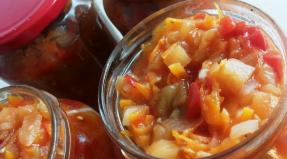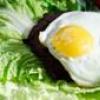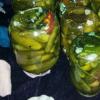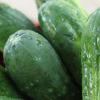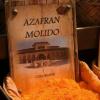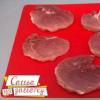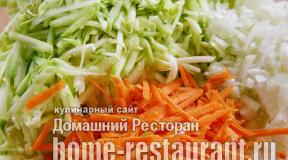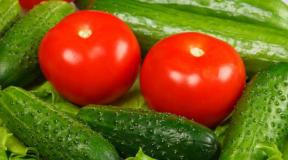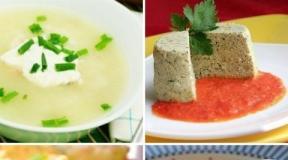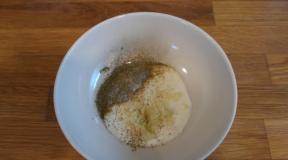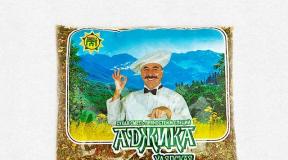Crimean Tatar cuisine. Crimean cuisine - a set of other people's recipes or exquisite pleasure? Recipes Crimean cuisine
Discovering local cuisine is an exciting part of every journey. However, many tourists who come to rest in the Crimea, believe that since we live in one country, then we have the same national dishes, which means that we should not even look for places that offer something special. And absolutely nothing! Crimean cuisine will offer many unusual dishes, and some may well become your favorite!
What to try in the Crimea?
The most distinctive dishes of the Crimean cuisine - Tatar. Nowhere except the Crimea, you will not try the national treats of the Crimean Tatars. Meanwhile, even well-known dishes prepared by professional local chefs will gain a new taste. Another argument in favor of the Crimean Tatar cuisine is cheapness: you can hardly find more affordable prices for food in Crimea in 2016.
What will tourists indulge Crimean Tatars? The main dish on the menu - pasties. These "meat pies" (namely, the name is translated from the Crimean Tatar) are prepared here with a special recipe. They are made from flour without yeast, with onions and peppers. According to the classic recipe for the filling, lamb is taken, but both beef and cheese pasties are very tasty. Roast them in oil, heated to 200 ° C. For those who love less fatty foods, Crimean cuisine will offer yantyk - this is the same cheburek, but fried in a dry frying pan without oil.
Another interesting dish is the cuette. This is a juicy pie with lamb, onions and potatoes. Yufahash - tiny dumplings again with lamb, which are eaten with broth. Sarma is a local analogue of stuffed cabbage: meat is wrapped in grape leaves. Lagman is very much loved in the Crimea - a rich soup of lamb with vegetables and special noodles.
Driving along the highways in the direction from Simferopol, you will certainly see big barrels near the road: tandoor samsa is sold here. Be sure to try these patties with lamb and onion, generously seasoned with spices. The prices for such food in the Crimea in 2016 are very affordable, and a rich and tasty lunch is provided! By the way, the quality of the dish is one of the best.
If you are looking for where to eat in the Crimea national cuisine, we can recommend to visit cafes and restaurants in Bakhchisarai - for example, near the Khan's Palace.
Arriving to rest in the Crimea, be sure to try the Black Sea fish and seafood. Even if you are not a fan of such dishes, we assure: prepared from fresh products, they will be much tastier.

The most "Crimean" can be called crooks of rapana and mussels. They are grown or caught right off the coast and delivered to restaurants without freezing. In terms of utility, it is difficult to compete with these dishes of the Crimean cuisine: protein, collagen, mineral elements in them are in an easily digestible form. The main secret of cooking seafood is minimal heat treatment. It is enough to keep them in water or in a pan just a few minutes longer than they should be - and they will become rude.
But from fish dishes you definitely need to try red mullet in the Crimea. Its high taste was appreciated by the ancient Romans, buying it "by weight" for silver. It tastes best just fried and seasoned with spices, so the price of food in the Crimea in 2016 will pleasantly surprise. An excellent choice would be Black Sea flounder and mullet. Where to eat delicious fish in the Crimea? We recommend to visit Balaclava: in the numerous restaurants on the embankment you can taste the most delicious dishes of the Crimean cuisine, watching the fishermen and enjoying the magnificent view!

And what's for dessert? The most obvious answer is baklava. Puff pastry with honey and nuts is sold everywhere in the Crimea (though you shouldn’t buy it on the beaches, there is a risk to get sick - read how). You can drink lunch with booze - a low-alcohol drink that is made from raisins, or fragrant tea from the Crimean herbs.
Crimea - This is a great place for a family holiday. Sun, sea, clean beaches, water parks and attractions, exciting tourist excursions - there is a lesson for everyone! Active rest is, of course, good, but Crimea has another highlight - the wonderful kitchen.
FOOD IN CRIMEA
To visit the peninsula and never try traditional local food, just a crime. After all, this place is a paradise for gourmets. It should be noted that Crimean cuisine - this is a truly unique phenomenon. Historically, in the territory of the peninsula since ancient times, many tribes and peoples lived. Ukrainians and Russians, Turks and Greeks - not to list them all! They brought many new items to local culinary traditions. It is this symbiosis that makes crimea kitchen unique and inimitable. The greatest demand in the territory Crimea enjoy dishes of Ukrainian, Russian and Tatar cuisine.
Crimean Tatar cuisine
First meal
The classic hot dish of Tatar cuisine is shurpa - an aromatic soup with lamb and vegetables. In the Crimea, there are several options for its preparation. Mostly they add sweet peppers, different types of tomatoes, a lot of greens and a few ringlets of raw or pickled onions, mainly when serving food to guests.
The most popular among tourists is the soup with flour dressing - tokmach. Cooked on lamb and turkey broth, it has a delicate, pleasant taste.
Yufahash is considered a traditional and to some extent ritual food of the Tatars. As you can see, the name is rather exotic, but in fact it is banal dumplings, although very unusual. The fact is that Yufahash is tiny in its form, from 10 to 15 pieces are placed on their spoon. According to Tatar traditions, the young wife is obliged to feed her husband with this dish on the second day after the wedding, because it is believed that in this way she shows her love, care and patience.
Second courses
Nourishing meat food made from mutton and beef, combined with vegetables and oriental spices, perhaps, nothing better can be. Sarma, pilaf, lagman - this is only a small part of what you can try in any cozy Crimean restaurant or a small cafe.
Pilaf is considered to be the national dish of the peoples of Central Asia. Rice, meat (chicken or lamb), carrots and onions are traditionally used to make it. But the Crimean plov, seasoned with fragrant oriental spices, will amaze even the most sophisticated gourmets. For lovers of oriental cuisine there are also many exotic dishes. Here, for example, sarma (in the Turkish cuisine - Dalma) - this is such an unusual variation on the theme familiar for many cabbage rolls. The only difference is that the filling, which is made from lean mutton, is wrapped in grape leaves. The recipe is original and non-standard, but it is thanks to this that the sarma turns into a real culinary masterpiece. Juicy minced meat in combination with grape leaves gives it extra tenderness and piquancy.
For lovers of oriental cuisine there are also many exotic dishes. Here, for example, sarma (in the Turkish cuisine - Dalma) - this is such an unusual variation on the theme familiar for many cabbage rolls. The only difference is that the filling, which is made from lean mutton, is wrapped in grape leaves. The recipe is original and non-standard, but it is thanks to this that the sarma turns into a real culinary masterpiece. Juicy minced meat in combination with grape leaves gives it extra tenderness and piquancy.
Lagman is considered to be a no less original dish, it is made from noodles and lamb, which is stewed in thick rich broth with vegetables and oriental spices.
Tatar cuisine is so diverse that, despite the abundance of meat products, there is also a lot of tasty food for vegetarians. First of all, I would like to mention imam-bayaldy - eggplants stuffed with chopped tomatoes with onions and garlic, parsley and raisins. It is difficult to call a dish originally Tatar, because it is common in Asia, but in the Crimea it is cooked simply amazing. Will delight vegetarians and saute - vegetable stew of eggplants, tomatoes, carrots, garlic and onions. Although sauté is more Georgian cuisine, it is no less popular in Crimea.
Bakery products
For lovers of baked goods, Crimean pastry is simply bliss. Here is a variety of dishes from unleavened, sweet, liquid and sour dough, that just the eyes diverge. And, of course, you need to try everything! From traditional Crimean pastries can be distinguished several dishes.
Kubete - puff pastry cake. Potatoes, meat and onions are used as fillings. Sometimes add additional ingredients, mainly rice and cheese. Previously, the cubette was baked only on holidays, but today it can be ordered in any institution. It is served exceptionally hot. There is a tradition according to which only a woman should put a cake on the table, but it is customary to cut it only for men. Chir-chir - Analogue chebureks. By the way, not every cook can cook delicious pasties, so there are only a few places on the whole peninsula where you can try real chir-cheer. Unlike regular pies, their dough should be light and literally melt in your mouth. Not only meat, but also cheese and many vegetables are used as a filling.
Chir-chir - Analogue chebureks. By the way, not every cook can cook delicious pasties, so there are only a few places on the whole peninsula where you can try real chir-cheer. Unlike regular pies, their dough should be light and literally melt in your mouth. Not only meat, but also cheese and many vegetables are used as a filling.
Samsa - patty with unleavened meat filling. This dish appeared on the peninsula a long time ago, although it has nothing to do with the Tatar cuisine, because Uzbekistan is considered its birthplace. Often these cakes have a triangular shape. By the way, for the preparation of samsa use special clay ovens - tandoor.
Baklava - sweet pastry, which is more popular in eastern countries, is a dessert of puff pastry, stuffed with nuts and honey.
The drinks
Crimean herbal teas. Made on the basis of mountain herbs, they are fragrant, have soothing properties. If you add some spoons of jam to tea, for example, from rose petals, quince or ericot raisins (plum variety), then its taste will become even more refined.
Crimean wines are known in many countries. The largest collection of these drinks can boast the winery "Massandra".
Booze - this is wheat kvass. The history of the name of this drink is interesting. Translated from the Tatar "booze" means "scandal, disorder," although if we take into account the fact that the strength of a booze is no more than 5 degrees, then it will hardly come to disorderly conduct. The drink is always served very cold, for which tourists appreciate it.
Sherbet is a sweet drink, honey is used to make it. It is known since the XIII century. Previously used more for ritual purposes (during the wedding and on other holidays).
Russian cuisine in Crimea
Dishes of Russian cuisine appeared on the peninsula with the arrival of the first Russian-speaking peoples on this territory. It happened at the beginning of the II millennium. Over time, Russian culinary traditions are fully rooted here, at this time the cuisine is considered the main Crimea. Among the dishes that are most in demand, we should highlight a few. Pancakes The history of their appearance dates back to the Middle Ages. This is a traditional dish of the Eastern Slavs. In Russia, it had a symbolic meaning, because many believed that pancakes were a symbol of the sun. In those days, they were baked only for holidays, mainly on Maslenitsa. Now pancakes are an excellent snack, easy to prepare and very tasty.
Pancakes The history of their appearance dates back to the Middle Ages. This is a traditional dish of the Eastern Slavs. In Russia, it had a symbolic meaning, because many believed that pancakes were a symbol of the sun. In those days, they were baked only for holidays, mainly on Maslenitsa. Now pancakes are an excellent snack, easy to prepare and very tasty.
Shangi is an ancient Russian dish that represents yeast dough pies that look like cheesecakes. For the filling is often used mashed potatoes (from potatoes or peas) or unsweetened cottage cheese. For the test, mutton or beef fat is used, so shangi in Crimea very popular.
Okroshka - cold soup. The first recipes for okroshka appeared in the 18th century. In fact, it is a mixture of vegetables, herbs (parsley, dill, green onions), meat (mostly black grouse, pork and turkey) and various types of fish. All this is crushed and dressed with bread kvass and sour cream.
Schi is another ancient national Russian dish. In fact - this is a multi-component soup. It consists of: cabbage, meat, spices, carrots and sour dressing (pickle, sour cream or apples). The peculiarity of the soup is that all products are not amenable to preliminary heat treatment. In other words, vegetables do not grill or stew in advance. This reception is characteristic only for russian cuisine.
 Pies - A special kind of baked pies. The dish received its extraordinary name due to the fact that it has an open center, through which melted butter was poured inside. Over time, the traditions and methods of cooking change and now do not do that, but the name remains the same. The range of pies is quite large: there are fish, meat and mushroom pies. Also, rice, eggs and cabbage are often added to the filling.
Pies - A special kind of baked pies. The dish received its extraordinary name due to the fact that it has an open center, through which melted butter was poured inside. Over time, the traditions and methods of cooking change and now do not do that, but the name remains the same. The range of pies is quite large: there are fish, meat and mushroom pies. Also, rice, eggs and cabbage are often added to the filling.
Beef Stroganoff - a simple dish that combines elements of French and Russian cuisine. The basis for it is finely chopped roasted beef, poured sour cream sauce. Served exclusively hot.
Ukrainian food
Ukrainian food more popular among the Slavic peoples, but the long neighborhood of the two peoples led to the fact that some elements from the Ukrainian cuisine penetrated into the territory Crimea.
First meal
 Borsch, or beet soup - just beet gives it a bright rich red color. When serving, always add sour cream or offer garlic dumplings.
Borsch, or beet soup - just beet gives it a bright rich red color. When serving, always add sour cream or offer garlic dumplings.
Cabbage - is a soup made from sauerkraut. It has counterparts in Russian, Slovak and Polish cuisine.
Pickle soup - pickled cucumber soup or cucumber pickle.
Second courses
The most sought after main dishes ukrainian cuisine in Crimea It is considered to be several dishes.Vareniki- a well-known flour product in the Slavic cuisine, although they received the greatest distribution in the Ukrainian lands. It has long been in Ukraine as a filling for dumplings used meat, mushrooms, berries or vegetables. But in the Crimea, they were more creative in preparing them: Tatars prefer to take hemp seeds (they taste like poppy to taste) and peas for the filling.
Zrazy (meat rolls). They are made from beef, which is beaten off, and wrapped in vegetables, mushrooms and boiled eggs. Mashed potatoes are served as a side dish.
Roast (meat stewed with vegetables) - traditional russian and Ukrainian dish, which gained popularity in the Crimea. Served without additional side dishes, often in a pot (so it keeps its temperature longer), sometimes it is only slightly watered with broth.
Bakery products
Connoisseurs of flour products should definitely try the traditional Ukrainian pastries.
Cheesecakes (cheese pancakes). The basis for their preparation is ground cheese, to which are added eggs and some flour (by the way, French cooks do not add flour to the cheese cakes!). Roasted in a skillet, sometimes additionally baked in the oven. It goes well with condensed milk, homemade sour cream and jam.
Dumplings - rich rounded buns made from yeast dough. Where they first started cooking is unknown. Many attributed this "miracle" of cooking to the French and Italians. Now there is a perception that pampushkas are the work of German chefs, but all these versions have not yet been proven. In Ukrainian cuisine, however, as in the Crimea, they are often supplemented with garlic dressing and served with borscht.
Pancakes are delicious potato pancakes, which have been transferred from Ukraine to the Crimea.
The drinks
 From Ukraine to the Crimea came the tradition of making many drinks, which have become an integral part crimean cuisine.
From Ukraine to the Crimea came the tradition of making many drinks, which have become an integral part crimean cuisine.
Kvass is a very ancient drink, it was first used in ancient Egypt. In the Slavic lands, kvass appeared about a thousand years ago. In Russia, the technology of its preparation was known to all, because it was thought that this was a symbol of well-being, therefore kvass should have been in every home. In total, in the Middle Ages, 500 varieties of it were known. The secret of making many of them has been lost: despite this, kvass remains a popular drink even now.
Uzvar (according to modern terminology - brewing) is a cold drink made from dried fruit, sometimes honey is added to it besides berries.
The Crimean cuisine really has a unique flavor, because for many centuries it has absorbed the best culinary traditions of different nations. Do you want to fully enjoy the taste of oriental sweets, wonderful pastries, try unusual meat dishes? All this will give you the Crimean cuisine!
Visiting any country, almost all tourists first of all get acquainted with local cuisine. Many vacationers are unaware of the many original dishes of the Crimean cuisine. The most distinctive dishes are Tatar cuisine. Only on the Crimean peninsula, you can try the most delicious and unusual dishes of the Crimean Tatars. In this article we will introduce you to the most popular types of Crimean food.
First dishes in the traditional cuisine of Crimea
The most popular "hot" dish of the Crimean peninsula is the so-called Shurpa. Shurpa is a soup with lamb and vegetables.
There are many recipes for making shurpa. Going to any cafe or restaurant, with high probability, you will find shurpa on the menu. As a rule, when serving shurpy, sweet pepper and several rings of fresh onions are added to it.
Another popular hot dish is tokmach. This soup is prepared with the addition of flour. It has a delicate flavor due to cooking on a special turkey broth.

Traditional for the Crimean cuisine is yufahash. Despite the unusual name, Yufahash can be called ordinary dumplings, but with an important difference. The fact is that these dumplings are very small and can fit in a spoon for several pieces. According to tradition, on the second day after the wedding, the young wife should feed her spouse with this treat. This tradition symbolizes her love and care for her husband.

Baking and sweets of Crimea
On the territory of the Crimea is a huge number of factories and plants for the production of confectionery. Thanks to this, in any store of the peninsula you can find a department with sweets and pastries.
Recently, pastry has become not only a delicious delicacy, but also an unusual souvenir. Many tourists buy sweets as a present. On the shelves of the tourist cities of Crimea you will find the following sweets:
- Sugar and chocolate puzzles;
- Cakes portraits;
- Chocolate souvenirs;
- Flowers of mastic.
In addition to sweet pastries and chocolate desserts, local Tatars have a spread called “ Kubete". This meat pie appeared in the Tatars under the influence of Greek cuisine. As a rule, Kubete stuffed with meat, potatoes and onions.

Eastern sweets are the most common in the Crimea. The most popular sweetness is baklava. Baklava is a small sweet pies made of dough with honey and nuts.

Also, on the territory of the peninsula you can find a large number of varieties. jam. Here it is made from apricots, plums, strawberries.
Traditional drinks
Drinking and preparing drinks is an integral part of the life of the Tatars. It has long been common among Tatars to drink bread, but the most common drink remains coffee. In restaurants and cafes of resort towns you can find a huge number of varieties of coffee.

Sour milk drinks are also very popular on the peninsula. Especially popular ayran and koumiss.
More to traditional drinks are different varieties of wine. Now on the peninsula there is a huge number of plantations of grapes from which local wine is made. Here you can try the following wines:
- Dry;
- White;
- Red;
- Sparkling
Read also our article. Cognacs, wines and wineries of Crimea: prices, reviews, how to distinguish a fake:
The best places with local cuisine in Simferopol
Most restaurants in Crimea offer their visitors traditional European cuisine, but there are a large number of places where people can familiarize themselves with the national dishes of Crimea.
Restaurant "Matisse"
This institution is considered one of the most popular in the whole of Simferopol. It is located at: st. 60 years of October, 37. Here you can both celebrate the holiday, and quietly eat in a cozy atmosphere. The entire menu range is prepared with great care and respect for all national traditions. The main specialization of the restaurant is meat treats and a variety of kebabs.

Restaurant "Matiss" in Simferopol
Restaurant "Kechkemet"
Another one of the most popular establishments among tourists is “Kecskemet”. It can be found at the address in Simferopol: ul. Gagarin, 22A. Here you can try almost any national dish of the Crimean Tatars. In addition to national treats, the restaurant has a choice between traditional and exotic cuisine.

Restaurant "Chistye Prudy"
Located at st. Kievskaya, 80. This restaurant has existed for about 15 years and during this time managed to establish itself as one of the best places in which you can get acquainted with a variety of Crimean cuisine. In addition to many dishes and desserts for visitors there is a huge selection of wines.

Where to try the Crimean cuisine in Sevastopol
Caravanserai
Address in Sevastopol: reed highway 6a. This cafe offers a wide selection of local dishes at fairly reasonable prices. “Crown” dishes of the cafe are called manti and shurpa. Most tourists begin their acquaintance with local cuisine in the cafe "Karavan-Saray".

Cafe "Persimmon"
This cafe is located at 32 km of the Sevastopol-Yalta highway, before turning on, and for many years has been delighting its visitors with succulent meat dishes cooked on the brazier. You can also relax here by drinking a cup of coffee with sweet baklava.

Authentic restaurants Evpatoria
Restaurant "Dzheval"
It is a popular institution with shades of national color. Located at Evpatoria, st. Karaeva, 10. The restaurant is famous for its meat dishes. The institution has a huge assortment of sweets and various pastries. An important feature of the restaurant is the observance of traditions, so there is no alcohol in “Dzheval”.

Cafe "Eastern Night"
The cafe is located in the historical center of Evpatoria, at the address: ul. Demysheva 2. It is very popular with locals and tourists. The main specialization of the cafe is the Crimean cuisine. In addition to food, the cafe has the opportunity to enjoy the views and dances of oriental beauties.

National cuisine of Crimea in Yalta
Restaurant "Chayka"
Located on the waterfront to them. Lenin, 15. Great place with a beautiful view of the Black Sea. In addition to local traditional dishes, there are European, Georgian and Mediterranean dishes. The restaurant also has hookahs for the most varied tastes.

Restaurant "Tubeteika"
A small cozy restaurant, located at the address: st. Drazhinsky, 50. In the restaurant menu you can find all the most popular dishes of the peninsula. The assortment is dominated by dishes of traditional Oriental cuisine. It has a convenient location near the center of Yalta.
The post contains 5 recipes of the Crimean classical cuisine, the author-performer is Elena Lagoda, she is a Crimean ethnographer.
1. Karaite pies - A favorite dish of all Crimeans and in general one of the culinary business cards of the Crimea. True, they are also very popular in Lithuania, where a rather large Karaite diaspora lives. In Lithuania they are calledkibinai (or Kibins). Karaite dough is crispy, and the filling is very juicy.
Ingredients
For the test:
Flour - 650 g
Butter - 250 g
Water - 200 ml
Egg - 2 pcs. + 1pc for surface lubrication
Salt - 0.5 tsp.
Sugar - 0.5 tbsp. l
Vinegar 9% - 1 tbsp. l
For filling:
Pulp of mutton or beef - 600 g
Onions - 2 pcs.
Salt
Ground black pepper
Fat fat (if meat is lean) - 100 g
Cooking method:
1. Sift flour into a bowl. Chilled butter finely cut or three on a coarse grater and combine with flour, add eggs, salt, sugar and water with vinegar and knead a homogeneous soft dough. You can do without vinegar, but with it the dough becomes more crispy, that is, the effect of puff pastry. Wrap it in a film, put it in the fridge for an hour.
Step 1. Knead the dough and put it in the fridge for an hour

2 . Traditionally for Karaite pies used lamb. Karaites did not eat pork. Therefore, if you do not like the flavor of lamb, you can replace it with beef. Fatty meat is adjusted to your liking. If you use lean meat, add a little fat tail. This will give the filling juiciness and flavor of lamb.
The meat is finely chopped or cut (but do not use a meat grinder, otherwise there will be no juiciness), add chopped onion to it. Stuff with salt and pepper, mix thoroughly.
Step 2. Prepare the filling for Karaite pies

3. We pinch dough-sized babies from dough and roll out thin flat cakes. At one half put a tablespoon of filling and combine the edge. Then we wrap the edge with a pigtail, like a big dumpling. If you do not know how to do this, please contact Google with the query “pigtail on dumplings” or cakes and watch one of the proposed video options. Usually, Google gives out a large number of very intelligible short videos.
Step 3. We make pies

4. Sometimes in some literary sources I met the recommendation to make “nose” in Karaite pies - holes with a tweezer for steam. I DO NOT ADVISE to do this. Since in this case, the juice is ugly, it flows out and remains on the patty, in addition, the filling remains dry and inconsequential, and the pie itself does not swell without exposure to steam and remains flat.

5. Before baking, we pat the pies with egg and bake at 200 degrees for about half an hour. Serve hot !!! True, in the cold they are also very tasty.
________________________________________ ____
2. Kashyk-ash - spoon soup

This ancient dish in the Crimea is found in several nations. In the Crimean Tatars, kashyk-ash or sometimes another spelling, kash-kash, is translated as soup soup, in Krymchaks - suzme, in Karaites - hamur-dolma (complete. Stuffed dough), in Azov Greeks who came out of Crimea - Hashikhia. In fact - these are very small dumplings with meat filling. They are served along with the broth in which they are cooked. As a rule, sour milk or natural yogurt is added to kashyk-ash and is plentifully sprinkled with herbs. The size of the dumplings talked about the skill of the hostess. Their spoon should be at least 6-7. I fit 8 and even had another place.
Ingredients
For the test:
Water - 200 ml
Egg - 1 pc.
Salt - 1 tsp.
Flour - at least 4 stacks., But perhaps more (640 g)
Sunflower oil - 1-2 tbsp. l
For filling:
Beef - 200 g
Lamb - 150 g
Onions - 1 pc.
Ground black pepper
Salt - 1 tsp.
For serving:
Greens (onion, dill, parsley) - to taste
Curdled milk or sour cream - to taste
Ground black pepper - to taste
Cooking method:
1. From flour, water, eggs and salt, knead the dough. Cover it with a bowl, wrap or towel and leave for an hour.
Step 1. Knead the dough

2 . For mince meat and onion skip through a meat grinder. Salt and pepper. The choice of meat was determined by religious views, since Tatars and Krymchaks do not eat pork. The proportions of beef and lamb can be any.
Step 2. Cooking stuffing

3. On a well sprinkled with flour surface roll out a small piece of dough. The fact is that the molding of small dumplings takes more time than for ordinary ones, so the dough can dry. If you have an assistant in modeling - then you can cut the layer of dough into squares and quickly form dumplings. The dough needs to be rolled rather thinly, but not too zealous - otherwise the wet dough from the filling can break through. Squares should be no larger than 3 cm.
Step 3. We make small dumplings


If you make dumplings without an assistant, then you need to roll out the dough in small portions, cut it into strips, and fold the strips one upon another. In this case, the dough should be very steep and powdered with flour, so that the layers do not stick together. Stacked strips are easier to cut into equal squares. We put the ready-made squares on top of each other - so the dough dries less - and form small dumplings the size of a finger phalanx. Some craftswomen sculpted dumplings and the size of a nail.
4. Put the finished dumplings on a floured surface and let them dry for a while, then freeze or cook them immediately.
Step 3. Put the finished dumplings on a floured surface.

5. Dumplings dipped in boiled broth or water. Serve kash-kash immediately, without letting the dish cool. Season with ground pepper and sprinkle liberally with greens. Optionally, you can fill with sour cream, yogurt or natural yogurt.

_________________________________
3. Chebureks

Chebureks - the most popular dish of the Crimean cuisine, they are prepared in almost every home. Both my mother and grandmother often cooked pasties, at least once a month - that's for sure. This ancient dish is found in many Crimean peoples under various names. Chebureks - Crimean Tatar name, and the Krymchaks and Karaites they are called Chir-Cheer (similar to hissing oil during frying). Previously, they were cooked only with lamb and roasted in mutton fat. Now they are boiled in hot sunflower oil, and in the menu of numerous Crimean pasties, cafes and restaurants you can often find variations of cheese stuffing, tomato and even sweet pasties with cottage cheese. And all this is also very tasty.
The pastry in pasties is thin, very tender and slightly crunchy. Hot chebureks are always bubbly, puzatchenkie, and when biting, a delicious juice - broth flows from the filling. Needless to say, they need to be only hot, until the juice is absorbed into the dough.
Ingredients:
For the test:
Flour - 3.5 stak. (560g)
Water - 1 stack.
Salt - 1 tsp.
For filling:
Onions - 1-2 pcs.
Salt
Greenery
Black pepper
Water - about 0.5 stack.
For frying:
Refined sunflower oil - not less than 0.5 l
Cooking method:
1. From water, flour, salt and a small amount of vegetable oil, we knead a rather steep dough. Knead it up as long as it becomes smooth, elastic and glossy. Cover it with a bowl, wrap or towel and leave to rest for an hour.
2 . In the minced meat, add salt, lots of greens and ground black pepper. Finely chop the onion and, a little sprinkled with salt, we press it with our hands so that it becomes softer and not too noticeable in the ready-made pasties. Mix onions with filling, add water and stir. The consistency of stuffing should be a little thin, but not too much - so that the filling does not spread, and not thick - so that it remains juicy in the ready-made cheburek.
3. Pinch a ball of dough from the dough and roll out a thin circle with a diameter corresponding to your griddle or cauldron in which the pasties will roast. If the dough sticks to the board - just dust it with flour, but a little - so that the excess flour does not burn in oil. Spread a tablespoon of the filling on one half of the circle, cover with the second half and close the edge well. The edge of the dough is cut with a special knife for pasties. In the Crimean Tatars he was called chegyr.
4 . Pour a lot of oil into a cauldron or deep pan so that the pasties will float and do not touch the bottom. We warm it up very well, so that when the cheburek is lowered, it boils. Fry chebureks until golden brown. It is important that the dough does not have holes and the edge is well-molded, otherwise the juice will flow when frying and the oil will smoke strongly. We turn over and take out the chebureks with a skimmer.
We serve pasties right there! Immediately!!!
_______________________________________
4. Yantyki

In essence, yantyki are pasties, fried in a dry frying pan, without oil.. Freshly cooked them are abundantly greased with butter and covered, from which they become soft and very tasty. The result is a completely different dish from chebureks. It's hard to say which one tastes better, you need to try both!
Ingredients:
For the test:
Flour - 3.5 stak. (560g)
Water - 1 stack.
Vegetable oil - 2 tbsp. l
Salt - 1 tsp.
For filling:
Minced mutton or beef - 200-300 g
Onions - 1-2 pcs.
Salt
Greenery
Black pepper
Water - about 0.5 stack.
For lubrication:
Melted or softened butter - 100 g
Cooking method:
All stages of cooking before frying, that is, the dough kneading and preparation of the filling are no different from pasties.
Then we take a frying pan, preferably with a thick bottom, preferably a cast-iron one, heat it over medium heat and fry the yantyks without the use of oil, that is, in a completely dry frying pan. A couple of minutes on the one hand and the same on the other. If you are not sure that the dough is fried, you can re-turn the pan and let it bake for another minute.
Hot yantyki grease with butter and cover with a lid or a plate so that they are slightly steamed and softened. Served, of course, hot!
___________________________________
5. Stuffed Jewish fish (gefilte fish)

I learned about this dish from my grandmother, who had long lived in the same yard with a Jewish family. The peculiarity of this traditional dish for the Crimean Jews is that they remove the skin from the fish as a whole “stocking”, stuff it and then boil it with beets, onions and carrots. Probably appropriate to mention that in the 20s of the twentieth century. A large number of Jews moved to the Crimea and the peninsula even wanted to make Jewish autonomy.
This is a very difficult dish, both in terms of cooking technology and its value, which is simply huge for Jewish culture. It is possible to translate gefilte fish from Yiddish not only as a stuffed fish, but a full, rich fish. It is served on Passover and Rosh Hashanah holidays, moreover, it is ideal for the Sabbath, since, prepared on Friday, it does not contain bones, which means that the Jewish ban on the extraction of bones on Sabbath day is not violated.
Cold stuffed fish is a very tasty dish. It is served in different ways. Some are served with broth, like a cold first course, and some get the broth to solidify and serve as aspic.
My friend and colleague Yevgeny Melnichenko, who is just making gefilte fish jewelery, I found out the subtleties of cooking. By the way, Eugene is a terrific artist, a master of woodcarving, many of his products are dedicated to Jewish art.
Ingredients
For fish:
Pike or pike perch - 1.5 kg
Onions - 2-3 pcs.
Matsa - 100 g
Dill - 0.5 puts.
Raw eggs - 2 pcs.
Boiled peeled whole eggs (small) - 3 pcs.
Salt - to taste, but a little more than usual
Ground black pepper
For broth:
Raw beets - 2 pcs.
Raw carrots - 2 pcs.
Onion - 1 pc.
Husk of yellow and red onions
Bay leaf - 3-4 pcs.
Black pepper peas
Brown sugar - 0.5 tbsp. l
Salt - to taste
Water
Cooking method:
1 . First, let's stop on the choice of fish. I consider it an ideal fish for this pike perch dish, although pike or carp are considered traditional for stuffed fish in the world. Perfectly and pelengas.
We clean the fish from the scales, remove the gills, cut off all the fins except the caudal, remove the gill bone, but try to keep the head attached to the body along the back. Then we go under the skin with our fingers and separate it from the meat. In the place of the dorsal fin under the skin we cut the bones with scissors, trying not to damage the skin. So we reach the tail, gradually turning the skin inside out. At the end of the scissors we separate the ridge from the tail, again, trying not to damage the skin.
2. Before committing to cooking stuffing, collect the cut fins, ridge and scales (throwing away only the gills), pour with a liter of water and boil a clear broth over very low heat, slightly salting it. Strain the broth.
3 . Matsu cover with water and give completely soften. In supermarkets you can find many variations of matzo, from classic fresh to delicious salty with onions, poppy seeds and other fillings.
Finely chop the onion and half pass in vegetable oil, and leave the other half raw.
Meat is separated from the bones and minced with a matzoh. In the mince add passerovanny and raw onions, salt, pepper, chopped herbs, two raw eggs. All mix.
4. Fill the fish with meat, but not too tight, but so that it takes the natural shape. Sometimes boiled eggs are put in the middle of the fish to make fish slices look more spectacular in the section. By the way, I noticed that with eggs inside the fish retains a more rounded shape when cooked and does not become flat.
5 . Put onion peel, peeled and cut beetroot and carrot, whole peeled onion, bay leaf, peas in the bottom of the pan.
6. Then put the fish belly down, back up and pour hot broth. It is not scary if the fish is completely uncovered. Salt the broth well and add a couple of teaspoons of brown sugar. If there is no brown sugar, it can be replaced with a bit of females: hold the floor of a tablespoon of sugar over the fire until it becomes caramelized and becomes light brown. Cook the fish with the lid closed for about two hours, removing the foam at the beginning. We wait for complete cooling and only then we take out the fish, trying to keep the head from coming off.
Strain the broth, heat and introduce gelatin, according to the instructions. Put fish on a dish, pour a small amount of jelly, let it cool well and decorate with lemon, beet, greens.
Pour the stuffed fish with hot broth and cook for about 2 hours.




________________________________________ _________
Another recipe for chebureks from the book "Karaite cuisine":

________________________________________ __________
Our blog has already published posts with recipes from seasonal Crimean products and Crimean recipes.
Perhaps it is difficult to imagine any other national cuisine that would combine so many traditions and features of different cultures. More than 80 ethnic groups live on the peninsula of Crimea: Russians, Ukrainians, Crimean Tatars, Armenians, Jews, Greeks, Karaites and many others. Each nation brought its own special dishes to the Crimean cuisine, which perfectly got acclimatized in the Crimean cuisine and fell in love with the locals.
Crimean cuisine. Photo: http://www.flickr.com/photos/astique/
The neighborhood with such countries as Turkey and Bulgaria has also significantly affected. supplemented the Crimean cuisine with oriental sweets, and with its traditional dish, known to all as stuffed Bulgarian peppers.
Crimean Tatar cuisine is very popular in Crimea. Many restaurants offer hearty meat dishes, mostly lamb or beef, as well as a rich variety of pastries.
Crimean meat dishes
The main favorites among meat dishes are Lagman, Plov and Sarma.
These dishes appeared thanks to the Crimean Tatars, who returned to the peninsula in the 80s from Uzbekistan, where they were deported in 1944.

Meat dish - lagman. Photo: http://www.flickr.com/photos/andrew_hyatt/
Lagman - rich dish resembles soup, but more dense. It is prepared from meat (mainly lamb), special long noodles and vegetables. Vegetables are most commonly used eggplant, pepper, radish, potatoes, onions, carrots. And, of course, add spices and various greens.

Pilaf. Photo: http://www.flickr.com/photos/iknowhim/
One of the favorite dishes of Crimea is plov. In each region, it is cooked in its own way, but, nevertheless, the foundation remains the same: meat, rice, onions, carrots and spices. In whatever version it is cooked - it is always incredibly tasty and very satisfying.

Meat in grape leaves - Sarma. Photo: marakand.com.ua
Sarma is also widespread (it is dolma) - it is stuffed cabbage, but only the filling is wrapped not in cabbage leaves, as we used to, but in grape leaves. The unique combination of meat filling with grape leaves, slightly sour, leaves will not leave indifferent any gourmet.
Crimean pastry
In Crimea, they love to bake pies, pies and many other dough products. Apply and yeast dough, and bland, and rich, and sour.

Crimean dish - a cuget. Photo: perekop.info
Of the traditional pastries, it is worth noting the cute - a juicy pie with meat, potatoes and onions. Other fillings are also used for the cubeta, such as rice and chicken, rice and meat, cheese and potatoes. They bake it mainly for celebrations.

Crimean Cheburek - Chir-chir. Photo: http://fotki.yandex.ru/users/khavalits58/
Also in the Crimea almost everywhere "Chir-chir" is found - this is an analogue of a cheburek. Chir-chir treat Karaite cuisine. It happens with meat stuffing or with vegetable. They also say that real Crimean pasties do not crunch and are not hard, but literally melt in your mouth.

Crimean triangular patties - Samsa. Photo: http://www.flickr.com/photos/dollzi/
Samsa refers to the Uzbek cuisine, however, perfectly got accustomed to the Crimean. This is a kind of unleavened patty stuffed with minced meat, onions and spices. The shape can be round or triangular. They bake samsa in a tandyr (clay furnace in the form of a cylinder), sticking it to the walls of the furnace. Now there are many variations of samsa cooking, but the most authentic and traditional, of course, is tandyr.
Crimean sweets
Eastern sweets are the most traditional for the Crimea. Favorite delicacy of the Crimean coast - baklava. Sweet cakes in the form of rhombuses from multi-layered dough with honey and nuts. It tastes soft, crumbly and very sweet.

Baklava. Photo: http://www.flickr.com/photos/theguideistanbul/
Analogue baklava - Sheker kyyyk - the national sweetness of the Crimean Tatar cuisine. The name translates as "sugar handkerchiefs." Sheker kyyk is also baked from multilayer dough, only topped with sugar syrup.

Jam from rose petals. Photo: http://www.flickr.com/photos/ [email protected]/
What about jam? In Crimea, it is prepared in various variations: from apricots, strawberries, quince, dogwood, raisin (these are small Crimean plums) and ... from rose petals. This original pink jam is very delicate in taste, and it emanates a subtle scent of roses.
Crimean wines
